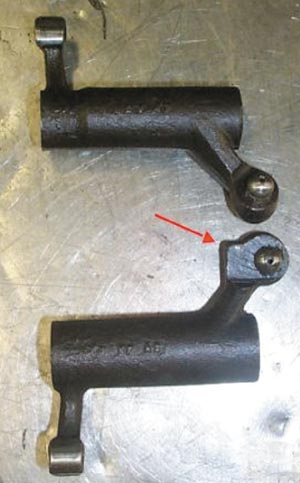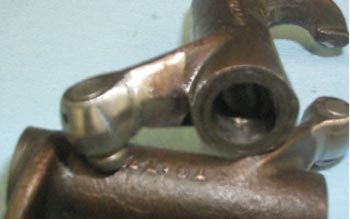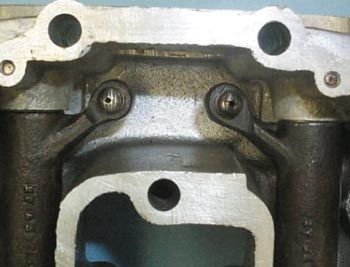250 Triumph/BSA Rocker Arm Mods
As a professional Triumph and BSA mechanic during the early 1970’s, I remember the 250cc
singles very well. They were great to work on and fun to ride. One of the problems that recurred
with great frequency was loss of compression. This was especially a problem with owners who
let a “friend” (accustomed to the high RPM of a Honda) borrow their bike. For the owner it was
hard to diagnose, because the engine would run ok until the ignition was turned OFF. Then it
could never muster enough compression to crank again.
To repair this problem, the first step is to remove the cylinder head and RH engine covers to
inspect the entire valve train. The cam followers should slide in the engine case over their full
length without binding, and fall out from the fully-lifted position under their own weight. A bent
cam follower will stick at its extreme lift point.
The exhaust valve can easily be checked for leaking by holding the exhaust port straight up and
pouring in thin solvents, while watching the inside of the combustion chamber. A bent valve will
let solvent gush by. A valve in good condition should hold mineral spirits for at least 3 seconds.

Photo 1 showing stock rocker arms and the compression release lug
After replacing the valves and lifters you have repaired the damage, but not the cause. The real
culprit is that the valve train weighs too much to sustain high RPM. You could install heavier
valve springs, but that only wears out the cam and cam followers. To prevent this from
happening again, you must lighten the valve train by reducing the reciprocating weight.
Most of this weight is found on the rocker arms. Repair requires an electric bench grinder and/or
a 1” belt sander, and a little time. It does not require a lot of skill, just patience!
The idea is to remove the weight from the portion of the rocker arms with the greatest travel.
Weight near the center of rotation is not nearly as important a weight at the tips of the arms. The
boss used for the compression release is a special target. These rocker arms are common to 500,
350 and 250 models, but the 250s did not have a compression release. Therefore the compression
release lug can and should be removed.
Work slowly and let the following photos be your guide.

Photo 2 showing a typical street grind
Here are some hints and tips to remember:
To retain full rocker arm strength do NOT reduce the height of the arm, only the width of
the arm. The finished arms should be oval in cross-section.
The reciprocating weight is more critical the higher you intend to rev the engine, so for
street use or touring, don’t get carried away.
Removing material does increase the internal stresses, but this is easily offset by surface
finish. The more material you remove, the smoother the final finish has to be. Street grade
rockers can be sanded smooth; racing rocker arms must be polished.
Internal stresses can also be reduced by leaving generous radii, called fillets. Stay away
from making any sharp corners or deep score marks. Blend all the surfaces.
When the rocker gets warm, stop grinding and drop it in a large bucket of water. Work on
the other rocker arm in an alternating tag-team approach.
To keep from dinging the polished push rod tip simply knock it out with a small punch
before grinding. It’s not installed very tightly. You can easily reinstall it by pressing the
arm and tip together in a bench vise.
Some rockers have a drilled oil hole. To keep from grinding into the oil line, simply insert a
drill bit after removing the tip. You’ll be able to visualize the oil hole location much better.

Photo 3 showing the rocker box ready for installation
When you’re happy with the result be sure to wash the rockers with plenty of clean solvent and
blow out with compressed air. The abrasive materials used for grinding will remove as much
metal from the inside of your engine if you fail to clean the rockers thoroughly.
Happy thumping
Richard F Whatley
Mechanical Engineer
Triumph training school graduate
Suwanee, Georgia USA
Mail to Richard F Whatley
Updated 21:27 2004-09-15
© Rickard Nebrér


